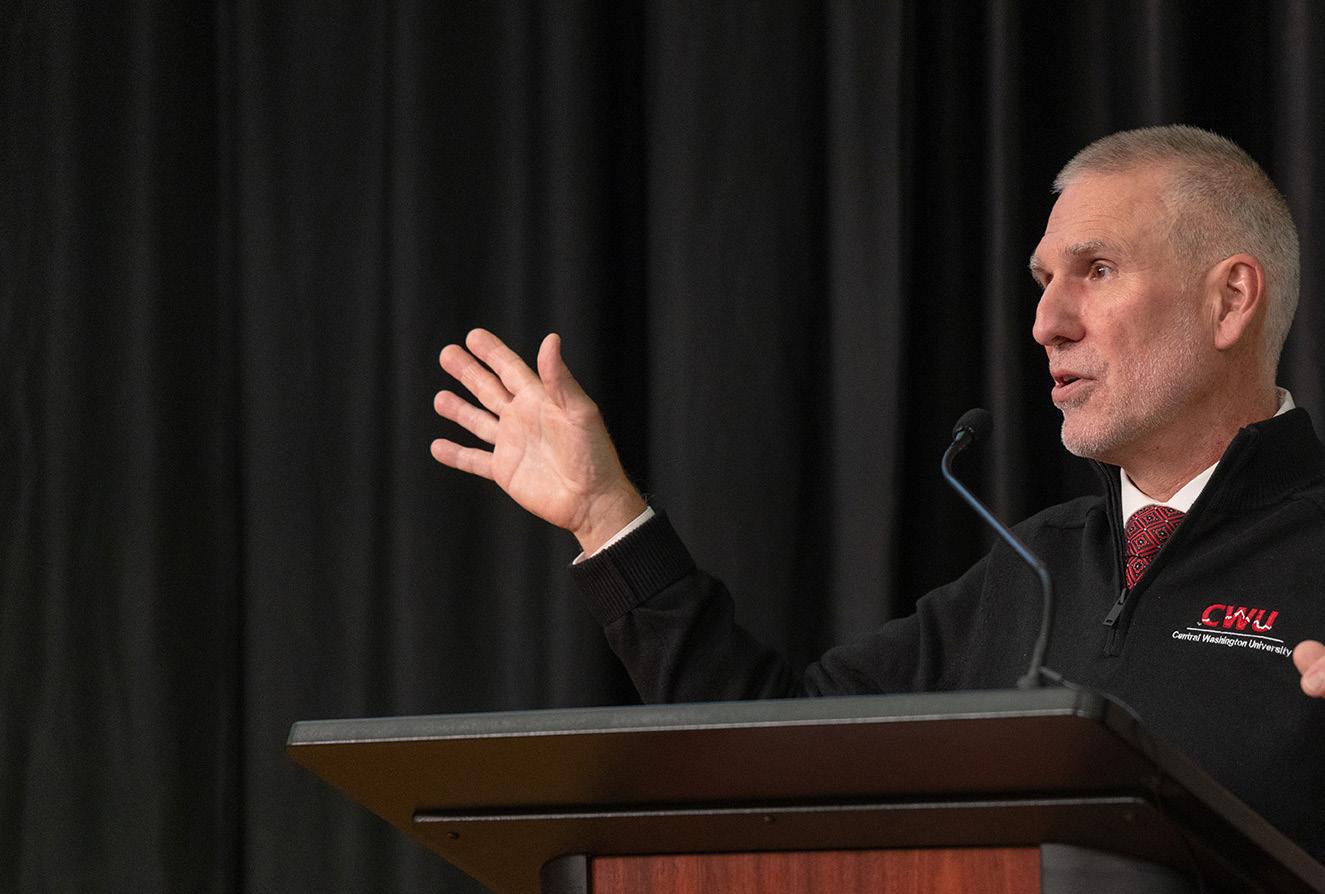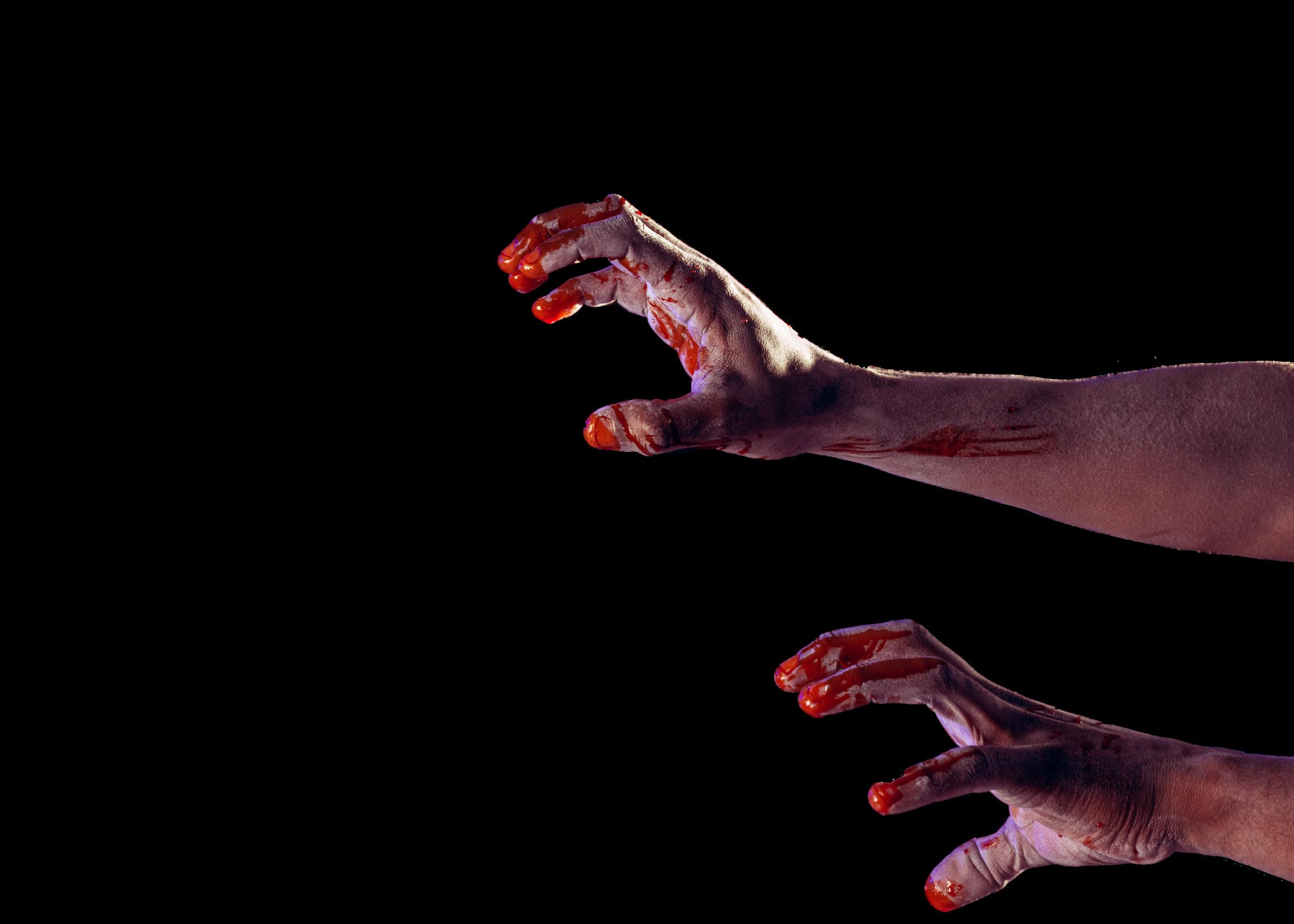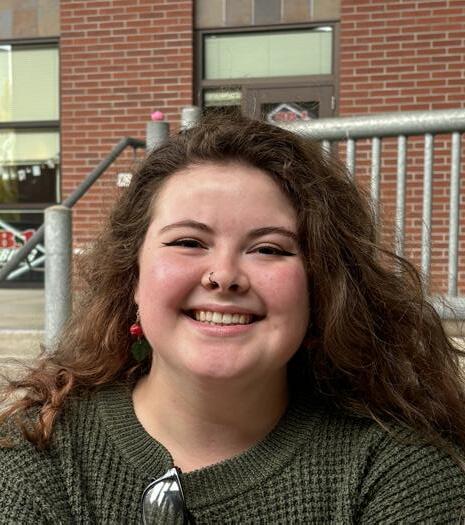


By the students, for the students






Brandon Mattesich & Jackson Roberts Co-Editors-In-Chief
CWU Administration has been using the idea of “attrition” for adapting the university’s staff size to its new student population for at least the past four years. With college enrollment on a steady decline since the pandemic in 2020, universities nationwide have been forced to adapt to smaller student populations and reduced federal funding. CWU has taken a distinctly “different” approach to handling that decrease, and its effects are being felt across the university.
Joel Klucking, senior VP of finance and administration, described how CWU is operating under this new financial situation as an “attrition model,” stating, “We have acknowledged early on that this [how CWU handles a smaller student body] was something that we needed to pivot on,” Klucking said. “As enrollment has declined, we have done the things necessary to try to match the number of faculty and staff for a student body our size.”
“Our [model] is called the attrition model, so we figure out if we’re going to replace positions when they become vacant,” Klucking continued. “We haven’t laid anybody off, technically. A lot of universities just say, ‘Well, I have a $20 million deficit, and I’m going to cut $20 million right now.’ There’s two different ways of doing it, and I think our way in a small community is
“Our (model) is called the attrition model, so we figure out of we’re going to replace positions when they become vacant. We haven’t laid anybody off, technically.”
- Joel Klucking, senior VP of finance and administration
probably less painful, but that’s up for debate.”
Last year there were 8,509 students enrolled at CWU, this year there are 8,309, a 2% drop. That drop however, is less than what administration at the university had anticipated, so the university’s financial planning was set to account for this drop ahead of time, according to Klucking.
At a gathering with local media on Oct. 23, President Jim Wohlpart shared a similar sentiment to Klucking on the university’s financial standing. “We are very different than just about any other university across the United States. And what I would say is despite all the challenges that higher education is facing and that Central Washington University is facing, with budgets and what is happening at the federal government, we’re in a really good place.”
One of the things that makes Central different from other universities of a similar size is the vast quantity of degree paths offered. While “attrition” does affect the number of staff and faculty on campus, Klucking said that the university does not want it to impact the programs offered.
“We’ve tried really hard not to cut programs, because that’s the reason that students come here,” Klucking said. “There’s a natural cycle for programs, they’re created to meet a market need… and then at some point they reach their end of life and they are sunset, so there are programs sunsetting. We’re creating new programs all the time, and we’re sunsetting programs, but I don’t think it’s been for budget purposes.”
Wohlpart further spoke on how saved salaries from employees leaving are being put toward the university’s financial future. “We have about a $2.8 million deficit for the year,” Wohlpart said. “We are already a third of the way there, and covering that through salary savings. So when an employee tells us they’re leaving, it takes us three or four months to replace them. In those three or four months, we collect the salary savings from that, and that will fill that budget note. We will probably have a small surplus next year.”

A first look at the brand new NAC
Jackson Roberts Co-Editor-In-Chief
Local media had the opportunity last week to tour CWU’s newest facility, the North Academic Complex (NAC), scheduled to open in mid 2026. Director of Capital Planning and Projects Delano Palmer and Project Manager Joe Chanes led the tour throughout the building, which takes the place of the previous Language & Literature (L&L) building.
The $103 million dollar complex will have a modern flare, with a four-story central atrium, and will be home to a mock courtroom and a 240 seat auditorium. Spanning from the first floor to the ceiling is cross laminated timber from the Yakama Nation. The timber is compressed together, forming the same structural strength as steel and serving as a unique design compared to CWU’s other buildings.
“It is one of the most spectacular buildings that I’ve ever been in on a college campus,” CWU President Wohlpart said.
Chanes mentioned that on each wing of the NAC, they plan to have open floor plans to make sure that it is as inviting to students as possible. In those spaces as well there will be collaborative study areas for students, lounge seating, mobile marker boards and flat screen TV’s.
Palmer added to the importance of having these study spaces for students. “That is probably one of the most important recurring things, is the collaboration and allowance spacing. Capital planning works on improving every building, taking lessons from the previous one. One thing we learned is we did not have enough lounge space before class.”
“As we go through each one of these floors, you will notice an abundance of relaxation, collaboration space, sit-down space. The intention here is that when students get to the building, there is no need to leave. They can just relax before and after class and have plenty of space to do their work and study for class,” Palmer said.
Kyley Glenn News Editor
Central Student media received five awards at the national college MediaFest convention in Washington D.C. on Oct. 18.
The Observer had the chance to send two staff members, News Editor and Social Media Manager Kyley Glenn and Co-Editor-In-Chief Brandon Mattesich, to Washington D.C. for the conference. We traveled with PULSE Co-Editor-In-Chief Tyler Diltz, Creative Director Katrina Nolan and Faculty Adviser Jennifer Green.
Our newspaper placed 5th in the ‘Best of Show: Best Website’ category for the Associated Collegiate Press, and Central Student Media won an honorable mention in ‘The Reveille Seven Courage in Student Journalism
Award’ presented by the Student Press Law Center. for student media staffs’ outspoken defense of the publications during a defunding crisis last spring.
Our sister publication, PULSE magazine, placed 5th in ‘Best of Show: Feature Magazine for a four-year campus, second place design of the year for the Winter 2025 magazine cover and second place multimedia feature story for “Exploring Snoqualmie Tunnel.”
While there, we were able to explore many different panels organized to help college journalists and advisers improve their student media outlets. The one I found the most helpful and will be working on for The Observer was how to engage our online audience more.
There were also speakers from The Washington Post, The Society of Professional Journalists, The New York Times, and other legacy media organizations. We hope to keep participating in these conferences and receive recognition for the work we do both in and out of the newsroom for our paper.
Brandon Mattesich & Jackson Roberts
Co-Editors-In-Chief
When we took our roles as Co-Editors-In-Chief in winter of last year, we had plans of growing The Observer, building connections and trying, to the best of our ability, to honor the history of this 110-year-old institution. What we never expected is that during our tenure we would have to fight to keep it alive.
Last year’s situation regarding severe cuts to many different programs, the effects of which we are still dealing with, was one of the most stressful, challenging and gratifying experiences either of us have gone through. Because yes, we fought hard to keep this paper alive, and it took every single person at both The Observer and PULSE to do it, but we couldn’t have done any of it without all of you.
Meeting and getting to talk to all of you at the protests and budget meetings last year gave us the motivation to keep fighting, and is honestly the main reason The Observer is still here today. It is also the reason we were even able to get a nomination for, and place as a finalist for this incredibly prestigious award.
Because just a few weeks ago, the combined leadership of both The Observer and PULSE Magazine were recognized nationally as the only finalists for the prestigious Reveille Seven Courage in Student Journalism award for the coverage, ad-
vocacy and protests we organized in response to the proposed defundings of our publications last year.
This would not have been achievable without the unwavering support of everyone who showed their faces or even just reposted to social media our message fighting to keep student media alive at CWU.
The 400+ signatures from students, staff and alumni on our petition showed the importance of keeping a student press on campus and it is difficult to put into words the immense gratitude and thanks we have to everyone who has joined us along this journey.

When we had a chance to go to the 2024 Associated Collegiate Press conference in New Orleans almost exactly a year ago, the previous winner of this award spoke about how they were literally arrested for simply covering a political protest. To have our names in the same category as reporters like them is such an honor and a testament to the hard work put in by our team here at not only The Observer, but all of student media. So one last time, thank you to everyone who has supported so far, and we hope you all will continue to support as we do our best to keep The Observer and PULSE alive.



According to Wohlpart, Central has been following this practice over the past four years, saving the salaries from vacant positions and using it to balance the budget. He stated that, “At the executive level, we prioritized positions,” talking about how after a position is vacated the university looks at what the position’s responsibilities were, if they can be redistributed or replaced, and if that position needs to be refilled. This is the basis of the “attrition” model. But the model is not without its downsides, Klucking noted, citing predictability as one. “The downside to the attrition models is that you can’t really plan for what positions become vacant,” Klucking said. “But what we are asking the university to do is, when we have a vacancy, assess the work, get rid of what we can, because we don’t really want people to do more with less. And in fact, we’ve replaced the vast majority of the vacancies that we’ve
had, because we’ve realized … we have the work to do, we can’t do it differently. But the ask is that –how can we rethink the work and reimagine, are we doing things in silos that maybe we could do more broadly across the university with less employees? These are the hard questions that we’re having to ask ourselves.”
But with the “attrition model” in full effect, both Wohlpart and Klucking expressed that they believe CWU is in a relatively strong financial standing, with Wohlpart suggesting that Central might be one of the most prepared universities in Washington.
“Despite all the challenges that higher education is facing ... with budgets and what is happening at the federal government, we’re in a really good place.”
- Jim Wohlpart
When it comes to enrollment and retention rates, Palmer emphasized the point of making students feel like they belong here at campus – especially since the NAC is going to be primarily used by freshman and sophomore students as they embark on their college experience, serving as a first look of what college is supposed to be about.
“If you have been at Central for some time, you may have already had a class in Farrell Hall or L&L, which as a freshman is not an ideal welcome to Central. Now we have a building that says, ‘Welcome to Central, this is what college is supposed to look like,’” Palmer said.
The complex’s openness leaves plenty of space for sunlight to get through no matter where you are. “This is probably one of the only buildings on campus where faculty will have some version of sunlight. We’re not having a ton of people stuck in the middle of a building, you are either getting [sun] from the Atrium or the exterior walls,” Palmer said.
With the complex being heated and cooled through geothermal systems, Wohlpart noted the use of geothermal throughout campus and the positive impact it will have on the school, calling it a “gamechanger.”
“It will be heated and cooled with geothermal heat. We have a geothermal plant across the street in front of the psychology building and the Nicholson Pavillion. Our second geothermal building is going in soon and we just tore down the structure [in front of Black Hall],” Wohlpart said. “They will be a part of the work we’re doing to become a national leader in sustainability.”








Put simply, Halloween movies are not as scary as they used to be, and more importantly, they don’t feel very in tune with the holiday spirit. We all have movies that we watch during the holidays. Movies like “Home Alone,” to go with Christmas and “Hocus Pocus” to go with Halloween, but as the years have gone on there seems to be less and less Halloween movies that have a good, spooky, story about the holiday.
It seems like more and more the movies we have during that scary time of year are just meant to scare people and give them nightmares instead of having an actual story. I grew up watching movies like “The Addams Family” (1991), “Hotel Transylvania” (2012), and “Ghostbusters” (1984), but it seems like as the years have gone on movies have lost the spark that is the halloween spirit.
In recent years there has been a rise in movies that are just plain horror movies and don’t seem to have the touch of those earlier movies I talked about. Movies like “Terrifier 2” (2022) or “Halloween Ends” (2022), and even the highly popular “Fear Street” Trilogy (2021) are meant to be something where you need gore and terrifying jumpscares to keep you entertained or else you will lose interest.
And if you think about it, all of the movies you like or even love to watch on Halloween were probably from around 10 years ago or more. “The Addams Family” came out in 1991, “Ghostbusters” before that and even “Hotel Transylvania” came out over 12 years ago. If you can name a
good halloween movie that didn’t resort to gore then please do, but I bet if you really think about it you’ll see what I’m talking about.
I believe that the specific thing that the movies have lost is the quirkiness. The whimsy that comes with the earlier movies has seemed to disappear and has been replaced with something way more sinister. The sinister but funny laughs of “The Sanderson Sisters” or “The Addams Family” weird traditions kept my head tilted and I enjoyed how not normal the characters were.
This quirkiness is exactly what filmmakers and Hollywood are afraid of: the idea of being cringe. The idea of a film not having badass moments or something that isn’t perfect is terrifying to Hollywood. And that’s what’s creating this dilemma, at least in how I see it. Every movie that is slightly horror has to go all the way or they lose their audience.
I miss the movies that played with the ideas of monsters and the enticing stories of kids fighting off centuries old witches. And that’s another thing: kids. There are never kids fighting the monsters from their nightmares. If there are then it has to be an action movie or else again, you lose the audience’s attention.
According to recently released films, we need so much more nail-biting horror rather than movies with actual halloween spirit. Don’t worry about losing those movies cause they’ll keep on coming and if you want to watch the fun halloween films, then you can rewatch the classics.








Dim lights, antidotes, supply runs and zombies had CWU students rushing to Kennedy Hall for the “Zombie Zone.” Screams were heard from a distance, adding to the atmosphere of the pouring rain. On Oct. 24, the Residence Hall Association (RHA) asked volunteers to dress up as zombies and partake in a set of three separate obstacle courses.
High-school education major, Quinlen Casper shared his thoughts on the event. “It was kind of surprising and exhilarating. All the ‘zombies’ are really into it ... it feels like you’re actually on a mission, hunting them down. I think it was really cool, probably the best event that CWU has held this year.”
brief of our missions, each person was handed a Nerf gun and a pair of safety goggles. There seemed to be an overarching plot for the event.
I chose to take on the task of finding the antidote. I met up with the rest of the group at the designated time, where we were then shown a video of somebody in a lab coat talking about what the antidote looks like, and where to find it. Afterwards, we ventured into the dimly lit rooms, cautious of every corner.
seemed clear, then bam! A zombie crawled out from under the table in the corner, which had both of us shooting our nerf guns.
As our group finished up, I could hear screams throughout the building followed by laughter. Students seemed to jump at the opportunity to go again, rounding the corner of the building back to the sign-up desk. It was clear that there was a lot of care put into this event by the RHA’s.


After signing a waiver, I was met with the choices of finding an antidote, obtaining supplies or rescuing “survivors.” After a short de -
Volunteers were marked head to toe in fake blood and bruises, hiding behind corners and bits of cardboard. As I crept down a dark hallway with my group, a faint melody could be heard, “La la la.”
As our group reached the end of the array of rooms, we thought we had acquired the antidote scott free. On the contrary, as it was just me and one other group member, the room


The event was originally scheduled for the Saturday after; however, it was moved a day up in order to not conflict with the Rocky Horror Picture show taking place in the SURC ballroom, as they occurred at the same time. Despite the challenges presented, the Zombie Zone received a high turnout with 100 people.




Mulholland Dunlap
In their most recent evaluation with the CWU sustainability ambassadors, the As sociation for the Advancement of Sustainability in Higher Education (AASHE) designated CWU Sustainability as a Gold Certified Institute, according to their sustainability tracking, assessment, and rating system (STARS).

To celebrate their success, the CWU Sustainability staff and ambassadors led their quarterly forum, during which students, staff and faculty discussed their plans to continue making Kittitas County greener. The event occurred on Wednesday, Oct. 22, in SURC 137.
“It takes an entire campus community to bring home the gold,” CWU Sustainability Director Jeff Bousson said in his presentation during the quarterly forum. “Our Climate Action Plan got us a lot of points, but also all the innovative work that Capital Planning is doing on campus, that is what got us to gold, not to mention the amazing work that Dining did.”
Bousson said he felt honored to receive the title from AASHE.
“Other than UW Bothell, we’re the only public higher institution in the state of Washington to have a STARS gold rating, which is a benchmark of excellence,” Bousson said. “The reason why we got gold is because of the commitments that we’re seeing from our students and our staff and our faculty.”
The club purposefully chose a central location at which to host their forum. “These forums are nice. The location as well, being in the SURC, you usually walk past and see things, projects, moving,” health science and nutrition student Julia Yagelowich said.
After Bousson and CWU Sustainability Coordinator Jordan Spradlin finished their lecture, they and their ambassadors led a gallery-style discussion for all participants.
Sustainability Ambassador Brooke Cruz led the discussion titled “Student Ambassadors.” Cruz asked the participants in her station to, “share your ideas for engaging the campus and community through the Sustainability Ambassadors.”

“It’s really just trying to find a way to get your foot in the door with the students. And that is difficult; any small encouragement for them to attend, whether it’s an extra credit point in their sustainability,” Yagelowich said in response to the question. “I think that for residence halls, trying to give people notice with how much en -
The sustainability ambassadors and other enthusiastic students are currently working on Green Fund projects to help make CWU and the surrounding community more sustainable, ac -
For example, entrepreneurship student Liz Burt realized that gender-neutral restrooms are “very hidden when they’re on campus, with the one in the SURC in the back top of the building.” Therefore, for her sustainability project, she wants to work on making signs for such re -

“I have these signs that are here up on the surface, and then they would be up in other buildings around campus,” Burt said. “You scan the QR code that’s on there, and then pull up the campus with all of the locations with all gender-neutral restrooms to help people find them a little bit easier.”
Burt’s project is especially unique because it shows that sustainability means more than just the environment; it is also about the people.
“It has to do with people, influence and accessibility,” Burt said. “Different things are included in sustainability. And I think it gets lost, and people forget about that, because you think of sustainability as outside in nature.”
To respect and protect the environment, Sustain ability Ambassador Caydence Hesch is working on a project in which she encourages the Central Marketplace and other community vendors to store their food in reusable containers.
Third-year Ecology and Evolutionary Biology stu dent Kamran Hermann expressed admiration and enthusiasm toward Hesch’s Green Fund project.
“There is such a big benefit, but reusable contain ers, you need to wash them, and that is a whole process,” Hermann said. “Support for that process for getting their clean ones back and not ending up where it’s over and now it’s really close to washing it, really impacts whether I would use it, and I think a lot of other people would use it, as opposed to just ending up throwing them away.”
Overall, Bousson felt that his forum was a major success. “I’m thrilled to see at least 50 students, staff and faculty attend today’s forum. Especially seeing so many students attend today really means a lot,” Bousson said. “It was great to share high-level up dates on how we’re doing with our climate action plan, our sustainability report as well as our student Green Fund projects.”



Lucas Pierron Staff Reporter
Central Washington University recognized National Transfer Student week, from Oct. 20-24, hosting a variety of events both on and off campus to help spark some excitement and discussion about the role transfer students play in Central’s various university communities.
CWU’s student body has a strong representation of transfer students, with the annual accountability report estimating that around 40% of the undergraduate population on campus qualify as transfer students; but each transfer student’s stories are all varied and unique. No two transfer students are the same, and their educational/personal backgrounds highlight that the path to acquiring an undergraduate degree need not be traditional.
On Oct. 21, Iron Horse Brewery participated in the week’s festivities by hosting a trivia night, accompanied by offerings of discounted pints of beer. Here, graduated student Salem Kandee told The Observer about his path to achieving a bachelors in psychology from CWU, and how he was able to afford doing so thanks to community college.
“I went to Edmonds College for three years, and I didn’t even end up getting the associates because I was working full-time during then, but I thought it was valuable. I did really poorly in high school, and didn’t want loans or to leave,” Kandee said. Through working and then living on his own after high school, Kandee continued to share why he decided to make the switch to achieving an undergraduate degree, stating, “I already spent enough and earned enough credits [at Edmonds] that I knew a degree was worth it. But it’s hard. You can save a lot by going to community college.”
Later, a different transfer student offered his perspective on the undergraduate process. Josh Keller, a sophomore at DigiPen University, a private tech-centered school in Redmond, talked about his initial ambitions coming out of high school, and explained why he pivoted towards a degree in game design. “I was completely lost back then, and the only thing I wanted to do was hang out,” Keller said. “I took a couple classes at my community college and didn’t end up finishing that. Then I tried going to Western. But I had been out of school for three years at that point.”
Keller initially had thoughts about joining the military, but then found his passion in a niche program at DigiPen. “No matter what, it didn’t click until it did. I only felt comfortable once I had a solid vision of what was going to come next.”
Every student has a different definition of what’s “normal” in going to college, but the lives and stories of transfer students paint a bigger picture. There is no single correct path to a degree, and utilizing all resources available, such as the Transfer Center at CWU, can help make a student’s personal pathway as effective and valuable as possible.




Tage Dayton Staff Reporter
The Wildcats have had a strong start to the season, starting off the year by taking down the current number one and number two ranked teams in the National Collegiate Athletic Association (NCAA) Division II Western bracket in only three sets
There has been a star coming out of the recruiting class of 2025.
Freshman Outside Hitter Kailey Willsey is the rising star blocking up the middle for the Wildcats roster. She has recorded 72 blocks, which leads the team in blocks this season as a freshman. Her performance against Alaska Anchorage and Alaska Fairbanks earned her GNAC Defensive Player of the Week on Oct. 20. Overall, even though the averages of the stat sheet are down from last year’s team, the Wildcats are as competitive as ever, holding the 4th place slot in the GNAC with an 8-2 record while having played one less game than the top three teams.

The team did not hang their head, despite the recent loss to the Nanooks of the University of Alaska Fairbanks. In fact, they seem more competitive as they were seen getting into a very deep breakdown of film from practice. Getting to talk to Head Coach Mario Andaya and Willsey, both reassured what was to come from the ‘Cats for the rest
Though, there is someone else to spotlight for the matchup against the Nighthawks, and that is Redshirt Senior Outside Hitter Scottie Ellsworth. She tore apart the Nighthawk defense recording nine kills and four blocks on the way to a three to zero set sweep.
Next week, the ‘Cats come back home to Nicholson Arena to take on the Seattle Pacific University Falcons. The Falcons are sitting at eight wins and 11 losses in the season. The ‘Cats are hoping to keep the wins rolling as they come back home and stop the Falcons front runner this season, Megan Omlid, as the Falcons try to stop the Wildcats in their tracks.
The winning mentality that was shared between the team and the coaches was very present when talking to Andaya and Willsey. When asked about getting back to the seed or even pursuing getting to a higher seed in the west side of the bracket, Andaya said, “You know getting to the fifth seed is already good but we’re always trying to strive for better.”
Willsey had more to say about how they have worked into the winning mentality as a team, saying “We are all ready to win every week, like me and Hayli (Tri) really lock in and watch film trying to get better everyday.” The passion that the team has to win is unmatched, making it very hard to bet against them.
They took this winning mentality all the way to Idaho this weekend when they swept Northwest Nazarene University on the Nighthawks’ home court. The ‘Cats clawed down the Nighthawks on the back of a huge night from many players on the team.












Created by Rieley Iverson









